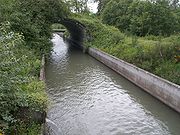
Flume
Encyclopedia


Water
Water is a chemical substance with the chemical formula H2O. A water molecule contains one oxygen and two hydrogen atoms connected by covalent bonds. Water is a liquid at ambient conditions, but it often co-exists on Earth with its solid state, ice, and gaseous state . Water also exists in a...
from a diversion dam
Diversion dam
A diversion dam is the term for a dam that diverts all or a portion of the flow of a river from its natural course. Diversion dams do not generally impound water in a reservoir...
or weir
Weir
A weir is a small overflow dam used to alter the flow characteristics of a river or stream. In most cases weirs take the form of a barrier across the river that causes water to pool behind the structure , but allows water to flow over the top...
completely aside a natural flow. Often, the flume is an elevated box structure (typically wood) that follows the natural contours of the land. These have been extensively used in hydraulic mining
Hydraulic mining
Hydraulic mining, or hydraulicking, is a form of mining that uses high-pressure jets of water to dislodge rock material or move sediment. In the placer mining of gold or tin, the resulting water-sediment slurry is directed through sluice boxes to remove the gold.-Precursor - ground...
and working placer deposit
Placer deposit
In geology, a placer deposit or placer is an accumulation of valuable minerals formed by gravity separation during sedimentary processes. The name is from the Spanish word placer, meaning "alluvial sand". Placer mining is an important source of gold, and was the main technique used in the early...
s for gold
Gold
Gold is a chemical element with the symbol Au and an atomic number of 79. Gold is a dense, soft, shiny, malleable and ductile metal. Pure gold has a bright yellow color and luster traditionally considered attractive, which it maintains without oxidizing in air or water. Chemically, gold is a...
, tin
Tin
Tin is a chemical element with the symbol Sn and atomic number 50. It is a main group metal in group 14 of the periodic table. Tin shows chemical similarity to both neighboring group 14 elements, germanium and lead and has two possible oxidation states, +2 and the slightly more stable +4...
and other heavy minerals. They are also used in the transportation of logs in the logging
Logging
Logging is the cutting, skidding, on-site processing, and loading of trees or logs onto trucks.In forestry, the term logging is sometimes used in a narrow sense concerning the logistics of moving wood from the stump to somewhere outside the forest, usually a sawmill or a lumber yard...
industry, electric power generation and to power various mill operations by the use of a waterwheel. Examples of flumes are Venturi flumes
Venturi flume
A venturi flume is a critical-flow open flume with a constricted flow which causes a drop in the hydraulic grade line, creating a critical depth.It is used in flow measurement of very large flow rates, usually given in millions of cubic units...
and Parshall flumes.
Specialist flumes
A flume can be used to measure the rate of flow. Specific designs include the Venturi FlumeVenturi flume
A venturi flume is a critical-flow open flume with a constricted flow which causes a drop in the hydraulic grade line, creating a critical depth.It is used in flow measurement of very large flow rates, usually given in millions of cubic units...
, Parshall Flume, Palmer-Bowlus, trapezoidal, and H-Flume. See flow measurement. A sewer pipe can be used as a flow measurement flume by using the Manning formula
Manning formula
The Manning formula, known also as the Gauckler–Manning formula, or Gauckler–Manning–Strickler formula in Europe, is an empirical formula for open channel flow, or free-surface flow driven by gravity...
.
In competitive swimming
Swimming (sport)
Swimming is a sport governed by the Fédération Internationale de Natation .-History: Competitive swimming in Europe began around 1800 BCE, mostly in the form of the freestyle. In 1873 Steve Bowyer introduced the trudgen to Western swimming competitions, after copying the front crawl used by Native...
, specialized flumes with transparent sides are often employed by coaches to analyze a swimmer's technique. The speed of the flow is variable to accommodate the full spectrum of swimming styles and ability.
See also
- AcequiaAcequiaAn acequia or séquia is a community-operated waterway used in Spain and former Spanish colonies in the Americas for irrigation. Particularly in Spain, the Andes, northern Mexico, and the modern-day American Southwest, acequias are usually historically engineered canals that carry snow runoff or...
- AqueductAqueductAn aqueduct is a water supply or navigable channel constructed to convey water. In modern engineering, the term is used for any system of pipes, ditches, canals, tunnels, and other structures used for this purpose....
- CanalCanalCanals are man-made channels for water. There are two types of canal:#Waterways: navigable transportation canals used for carrying ships and boats shipping goods and conveying people, further subdivided into two kinds:...
- LeatLeatA leat is the name, common in the south and west of England and in Wales, for an artificial watercourse or aqueduct dug into the ground, especially one supplying water to a watermill or its mill pond...
- Log flumeLog flumeA log flume is a flume specifically constructed to transport lumber and logs down mountainous terrain to a sawmill by using flowing water. These watertight trough-like channels could be built to span a long distance across chasms and down steep mountain slopes...
- Log flume (attraction)Log flume (attraction)Log flumes originally referred to a special construct used to transport lumber and logs down mountainous terrain to a sawmill by using flowing water. Today, however, the term is also used to refer to an amusement ride consisting of a water flume and artificial hollow logs or boats...

